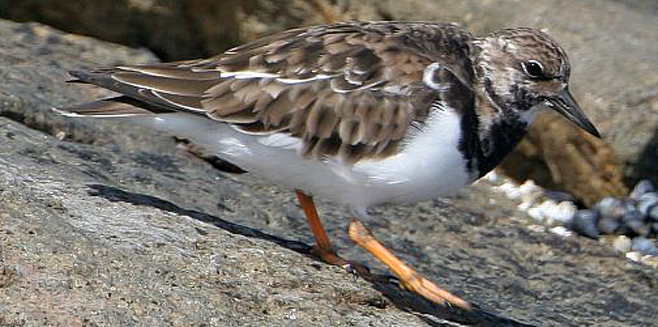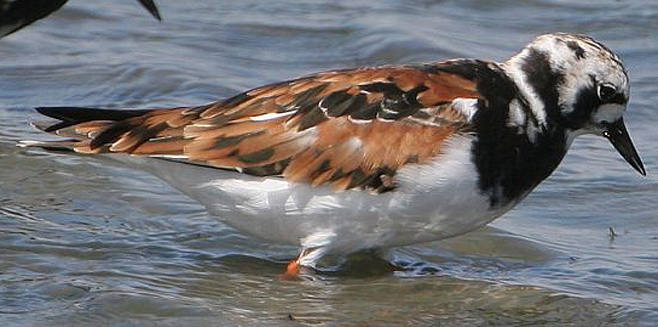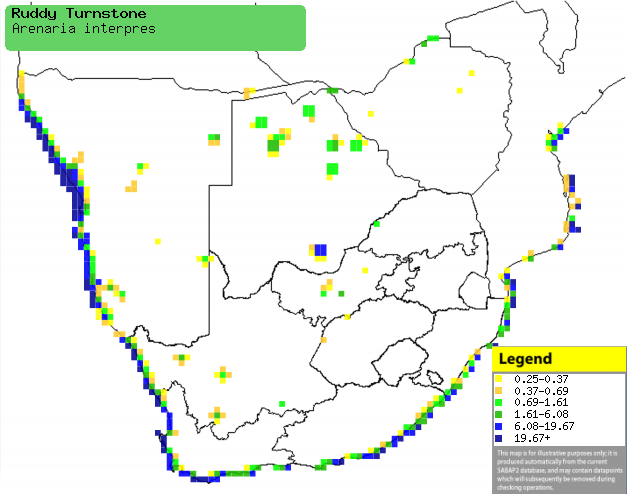|
Arenaria interpres (Ruddy
turnstone, Turnstone)
Steenloper [Afrikaans]; Steenloper [Dutch]; Tournepierre
à collier [French]; Steinwälzer [German]; Rola-do-mar [Portuguese]
Life
> Eukaryotes >
Opisthokonta
> Metazoa (animals) >
Bilateria >
Deuterostomia > Chordata >
Craniata > Vertebrata (vertebrates) > Gnathostomata (jawed
vertebrates) > Teleostomi (teleost fish) > Osteichthyes (bony fish) > Class:
Sarcopterygii (lobe-finned
fish) > Stegocephalia (terrestrial
vertebrates) > Tetrapoda
(four-legged vertebrates) > Reptiliomorpha > Amniota >
Reptilia (reptiles) >
Romeriida > Diapsida > Archosauromorpha > Archosauria >
Dinosauria
(dinosaurs) > Saurischia > Theropoda (bipedal predatory dinosaurs) >
Coelurosauria > Maniraptora > Aves
(birds) >
Order: Charadriiformes > Family: Scolopacidae
 |
|
Ruddy turnstone in non-breeding plumage, West
Coast National Park, South Africa. [photo
Trevor Hardaker ©] |
 |
|
Ruddy turnstone in breeding plumage, West Coast
National Park, South Africa. [photo Trevor Hardaker ©] |
Distribution and habitat
Breeds in the circumpolar above 65° North in Canada,
Greenland, Europe and Asia, dispersing across the world's coasts in the
non-breeding season to North and South America, western Europe, southern and
South-East Asia, Australasia, Pacific Ocean islands, Madagascar and Africa,
including southern Africa. Here it is common along the coastline of the region,
especially at Langebaan Lagoon in summer, while occasionally recorded far inland
in northern Zimbabwe and Botswana, Namibia and South Africa. It generally
prefers stony, rocky and kelp-covered shores, or sand flats covered with
eelgrass (Zostera), occasionally moving to inland wetland such as lake
edges, salt pans and river edges.
|
 |
|
Distribution of Ruddy turnstone in southern
Africa, based on statistical smoothing of the records from first SA Bird
Atlas Project (©
Animal Demography unit, University of
Cape Town; smoothing by Birgit Erni and Francesca Little). Colours range
from dark blue (most common) through to yellow (least common).
See here for the latest distribution
from the SABAP2. |
Movements and migrations
Intercontinental migrant, breeding from late
May to early August before heading south to the tropics, arriving in
the period from August-September but eventually getting to southern
Africa in September and October. Most birds depart in April,
occasionally in May, finally arriving back at their breeding grounds
in June.
Food
It mainly eats invertebrates, doing most of its foraging in
the day at low and high tide, turning over stones and algal mats with its strong
bill to access the food beneath or even gathering together in groups to turn
over particularly large objects, such as dead fish. The following food items have been recorded
in its diet:
- Invertebrates
- gastropods
- isopods
- Parisocladus perforatus (Isopod)
- polychaetes
- insect larvae
- amphipods
- bivalves
- ticks (including Ornithodoros capensis)
Threats
Not threatened, as it is common and occurs on six
continents.
References
-
Hockey PAR, Dean WRJ and Ryan PG 2005. Roberts
- Birds of southern Africa, VIIth ed. The Trustees of the John Voelcker
Bird Book Fund, Cape Town.
|
